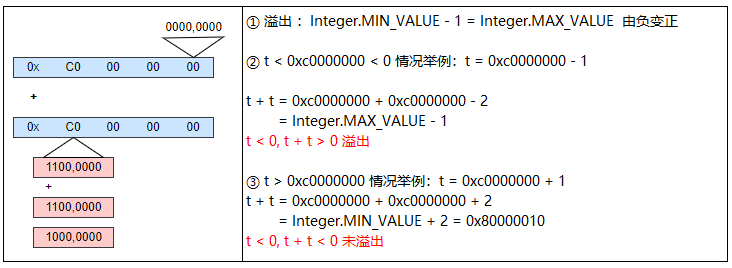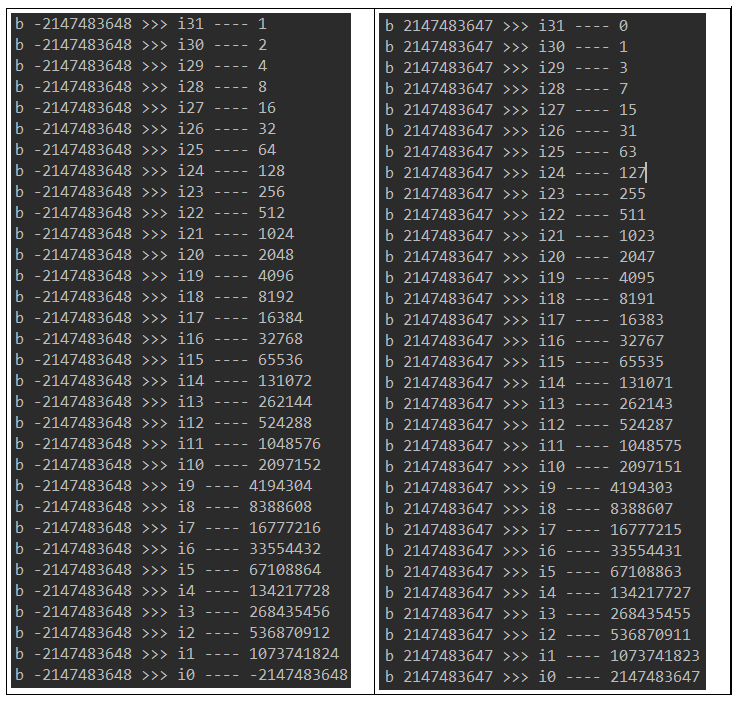0. Title Description

- Sword finger Offer II 001 Integer division
- Title Description: divide integers and round the result (discard decimal places)
- Title Requirements: do not use *, /,%
- Constraint condition: [- 231 - 1]. If the division result overflows, 231 - 1 will be returned
1. Content description
- The following four solutions come from Easy to understand Java/C++ /Python/js/go - integer division (Sword finger)
- Before looking at the solution, when I tried the idea of bit operation, I didn't know how to deal with the shift divisor 2. Later, after looking at the solution to understand the idea, I had a deep understanding of the boundary problem
2. Solution 1: subtraction instead of division
Version ①: A and b are positive, cycle condition b ≤ a, exceeding the time limit
class Solution {
public int divide(int a, int b) {
if(a == Integer.MIN_VALUE && b == -1){
return Integer.MAX_VALUE;
}
boolean sign = (a > 0) ^ (b > 0) ? true : false;
a = a > 0 ? a : -a;
b = b > 0 ? b : -b;
int cnt = 0, temp = b;
while(b <= a){
b += temp;
cnt++;
}
return sign ? -cnt : cnt;
}
}
Version ②: A and b are negative, the cycle condition a ≤ b, and the operation passes
class Solution {
public int divide(int a, int b) {
if(a == Integer.MIN_VALUE && b == -1){
return Integer.MAX_VALUE;
}
boolean sign = (a > 0) ^ (b > 0) ? true : false;
a = a > 0 ? -a : a;
b = b > 0 ? -b : b;
int cnt = 0;
while(a <= b){
a -= b;
cnt++;
}
return sign ? -cnt : cnt;
}
}
The analysis of the two items is planned to be understood from the bytecode level and written down for the time being
The core idea of the above code:
-
The symbol bits are extracted separately, and the symbols are added after the results are calculated by the same sign of a and B
Skills worthy of reference: use ternary operators to obtain the results of a and B symbolic operations
boolean sign = (a > 0) ^ (b > 0) ? true : false;, Boolean is used here instead of int, because the former is one byte and the latter is two bytes. Whether they will affect efficiency has not been studied -
Overflow processing: consider the data range [- 231 - 1], 231 needs to be considered here
a == Integer.MIN_VALUE && b == -1 -
Analysis on -231 the relationship between the two: java int type overflow?
3. Solution 2: subtraction optimization to reduce time complexity
Core idea: subtract the multiple of divisor every time you try

code:
class Solution {
public int divide(int a, int b) {
if(a == Integer.MIN_VALUE && b == -1){
return Integer.MAX_VALUE;
}
boolean sign = (a > 0) ^ (b > 0) ? true : false;
a = a > 0 ? -a : a;
b = b > 0 ? -b : b;
int cnt = 0;
while(a <= b){
int t = b;
int k = 1;
while(t > 0xc0000000 && a < t + t){
t += t;
k += k;
}
a -= t;
cnt += k;
}
return sign ? -cnt : cnt;
}
}
Description of T > = 0xc00000000 & & A < = t + T
- None of the above codes take =, the test is passed, and both sides take ==
- Explanation of 0xc00000000

- Explanation of a < = t + T when t == 0xc00000000:
① t + t = -215
② Value range of a [- 215 - 1]
③ When a = -215, a == t + t is satisfied
4. Solution: three bit operation optimization, time complexity reduced to O(1)
Core idea: in 3 It is realized by bit operation
code:
class Solution {
public int divide(int a, int b) {
if(a == Integer.MIN_VALUE && b == -1){
return Integer.MAX_VALUE;
}
boolean sign = (a > 0) ^ (b > 0) ? true : false;
a = Math.abs(a);
b = Math.abs(b);
int cnt = 0;
for(int i = 31; i >= 0; i--){
if((a >>> i) - b >=0){
a -= b << i;
cnt += 1 << i;
}
}
return sign ? -cnt : cnt;
}
}
Code analysis:
- Priority: > > > >+=
- (a > > > I) - explanation of b > = 0 instead of (a > > > I) > = b
① About math abs(Integer.MIN_VALUE) == Integer. MIN_ VALUE
/**
* <p>Note that if the argument is equal to the value of
* {@link Integer#MIN_VALUE}, the most negative representable
* {@code int} value, the result is that same value, which is
* negative.
* @return the absolute value of the argument.
*/
public static int abs(int a) {
return (a < 0) ? -a : a;
}
Note: if the input parameter in the comment is integer MIN_ Value, integer MIN_ VALUE
That is, math The result of ABS () is negative
② Verification of (a > > > I) positivity and negativity
public static void main(String[] args) {
System.out.println(test.count);
int a = -3;
int b = Integer.MIN_VALUE;
//int b = Integer.MAX_VALUE;
System.out.println(a + b);
System.out.println(Math.abs(b));
for(int i = 31; i >= 0; i--){
System.out.println("b "+ b + " >>> i" + i + " ---- " + (b >>> i));
}
}
Test b: take the maximum and minimum values respectively

Test results:
① When B = integer MIN_ Value (a > > > I) > = B is always true and enters the dead cycle
② When B = integer MIN_ Value is converted as follows
Let m = (a > > > I)
Then M - b > = 0 is equivalent to - (B - M) > = 0
The range of M > 0, - (B - M) is - [0, integer. Max_value] < 0. The equation does not hold